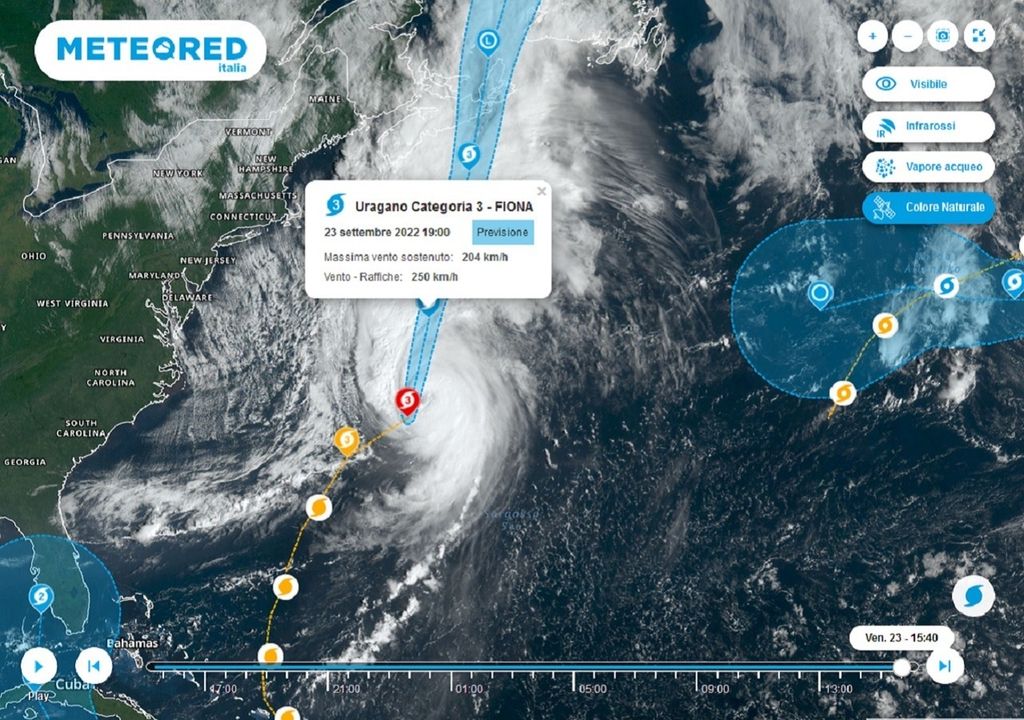
After devastating Puerto Rico, with strong winds, powerful storm surges and heavy rain, Hurricane “Fiona” climbs the western edge of an anticyclone in Bermuda, Maintains Saffir-Simpson Category 4 major hurricane status with moderate sustained winds of up to 210 km/h.
It is a very large hurricane that flows over very warm surface water that passes in front of Bermuda. Starting tomorrow, the storm will move up in latitude “Westerlies” and from the main branch “Polar Jet Stream” Outside of North America.
“Fiona” is likely to reach the Canadian coast with tropical conditions
As it rises in latitude, toward the subtropics, a truly powerful system of cyclones moves over an extended stretch of warm water in front of the East Coast. America. It cannot be ruled out that “Fiona” will reach the Canadian coast and hit Nova Scotia, retaining its tropical status.
But in all likelihood, the tropical cyclone will be intercepted within the next few hours by a poleward-looking trough descending from the Canadian Arctic, which could absorb the tropical cyclone. supporting its evolution into a system with extratropical characteristics.
Cold air flowing from the eastern part of the Canadian Arctic Archipelago, especially at higher altitudes, will close the depression led by Cyclone “Fiona” and favor its rapid evolution. A deep tropical cyclone as the storm approaches Nova Scotia.
So it is not driven by latent heat provided by the ocean surface (the engine of tropical cyclones), but by pure atmospheric dynamics (“Jet Streak ”,“ Baroclinicity“).
The storm’s impending impact on Nova Scotia
Despite its potential evolution into a tropical cyclone, it continues to retain some of the characteristics of tropical cyclones based on its origin.
More serious than anything else “Horizontal Baric Slope”, further enhanced by the gradual drift of cooler, denser, and heavier air toward the eastern Canadian coasts, poised for a sudden increase in pressure to the west of the depression. This will produce truly violent winds, initially from the eastern quadrants, ready to sweep Nova Scotia into the Canadian border.
Winds can be very strong along the coast of Nova Scotia. Enough to touch 130-140 kmph, peaks above 150/160 kmph. This wind was so intense that it spread over a large area of the sea, “Living Sea” waves form off the east coast of Canada, more than 8 meters high, and they can generate impressive tidal motion..
El Huracan #Fiona Bute Pasar a las libros de meteorologia d #Canada por diversos motivos pero pocas veces se ven avisos (Yo no he saw Ninguno) whence L @NHC_Atlantic A tropical sun system adentre al norte d #Canada Y al oste d #Greenland pic.twitter.com/wI3yBSimWZ
– RAM Revista del Aficionado a la Meteorología (@RAM_meteo) September 23, 2022
Precipitation and flood risk in eastern Canada
In addition to strong winds and large waves, this cycle is stressful It could bring heavy rain between Nova Scotia and eastern Labrador, along with gusty winds, ready to cause sudden reductions in horizontal visibility and localized flooding.
In fact, large amounts of tropical water vapor around the central core of “Fiona” will be swept north by strong winds at high altitudes, thus favoring the development of extensive cloud bodies. It will actually bring more precipitation, not just in Nova Scotia.
After impacting Nova Scotia, the remnants of “Fiona”, now a deep tropical cyclone with a cold heart, will move into the Labrador Sea, favoring its ascent. A large amount of tropical steam, up to Greenland.
What is the impact on the weather in Europe?
As we saw a few weeks ago, “Daniel” and “Fiona” can also influence the atmospheric circulation expected in Europe in the coming days in its northward movement.
As the remnants of tropical cyclones, particularly powerful and built up to high altitude, return to the North Atlantic, they, Through their imposing centrifugal force and their “ejection”, a “disruption” occurs that affects the entire hemisphere, causing the main branch of the “polar jet” to deviate.
In this case, the remnants of Cyclone Fiona will be able to churn up its main branch, which goes as far north as the Labrador Sea. “Polar Jet”Supports the development of a large bandwidth (Rossby wave) to Greenland. This tidal wave feeds a strong anticyclonic promontory that extends in the direction.Iceland.
A poleward pulse of high pressure over the Azores favors the cold air, polar sea, moving slightly eastward towards Europe.
Reflections on Italy
Some of this fresh air will also dump over Italy at the start of the week, causing a new widespread drop in temperatures. Especially in the north-central regions, there is an unusually cold period.
Colder air from the polar latitudes ends up over the still warmer waters of the Mediterranean Sea, However, it causes a lot of instability with the risk of more intense rain, showers and thunderstorms.. Often these events, even violent ones, affect above all the central-northern regions and the Tyrrhenian sector.

“Total coffee junkie. Tv ninja. Unapologetic problem solver. Beer expert.”









Leave a Reply